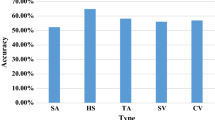Abstract
Accurate analysis of Alzheimer’s Disease (AD) from healthy patients is a significant concern. The knowledge about the condition’s seriousness and formative dangers due to AD leads to take prudent steps before the permanent brain damage takes place. Lately, there has been incredible benefits of computer-aided diagnosis (CAD) which uses various machine learning (ML) techniques for assisting the medical staff for AD diagnosis. In this paper, we proposed a model based on support vector machine (SVM) and made a comparison with three other classification algorithms for predicting normal control (NC) patients from AD patients. Lastly, the performances of the different algorithms are compared, and results of the model clearly indicate that gives quality performance for NC and AD classification.
Access this chapter
Tax calculation will be finalised at checkout
Purchases are for personal use only
Similar content being viewed by others
References
Alam, S., Kwon, G.R., Initiative, A.D.N.: Alzheimer disease classification using kpca, lda, and multi-kernel learning svm. Int. J. Imaging Syst. Technol. 27(2), 133–143 (2017)
Beheshti, I., Demirel, H., Matsuda, H., Initiative, A.D.N., et al.: Classification of alzheimer’s disease and prediction of mild cognitive impairment-to-alzheimer’s conversion from structural magnetic resource imaging using feature ranking and a genetic algorithm. Comput. Biol. Med. 83, 109–119 (2017)
Dana, A.D., Alashqur, A.: Using decision tree classification to assist in the prediction of alzheimer’s disease. In: 2014 6th International Conference on Computer Science and Information Technology (CSIT), pp. 122–126. IEEE (2014)
Dening, T., Sandilyan, M.B.: Dementia: definitions and types. Nursing Standard (2014+) 29(37), 37 (2015)
Jenkins, R., Fox, N.C., Rossor, A.M., Harvey, R.J., Rossor, M.N.: Intracranial volume and alzheimer disease: evidence against the cerebral reserve hypothesis. Arch. Neurol. 57(2), 220–224 (2000)
Johnson, P., Vandewater, L., Wilson, W., Maruff, P., Savage, G., Graham, P., Macaulay, L.S., Ellis, K.A., Szoeke, C., Martins, R.N., et al.: Genetic algorithm with logistic regression for prediction of progression to alzheimer’s disease. BMC Bioinf. 15(S16), S11 (2014)
Marcus, D.S., Fotenos, A.F., Csernansky, J.G., Morris, J.C., Buckner, R.L.: Open access series of imaging studies: longitudinal mri data in nondemented and demented older adults. J. Cogn. Neurosc. 22(12), 2677–2684 (2010)
Marcus, D.S., Wang, T.H., Parker, J., Csernansky, J.G., Morris, J.C., Buckner, R.L.: Open access series of imaging studies (oasis): cross-sectional mri data in young, middle aged, nondemented, and demented older adults. J. Cognit. Neurosc. 19(9), 1498–1507 (2007)
Patterson, C.: World Alzheimer Report 2018: The State of the Art of Dementia Research: New Frontiers. Alzheimer’s Disease International (ADI): London, UK (2018)
Reitz, C., Brayne, C., Mayeux, R.: Epidemiology of alzheimer disease. Nat. Rev. Neurol. 7(3), 137–152 (2011)
Sluimer, J., Vrenken, H., Blankenstein, M., Fox, N., Scheltens, P., Barkhof, F., Van Der Flier, W.: Whole-brain atrophy rate in alzheimer disease: identifying fast progressors. Neurology 70(19 Part 2), 1836–1841 (2008)
Tufail, A.B., Abidi, A., Siddiqui, A.M., Younis, M.S.: Automatic classification of initial categories of alzheimer’s disease from structural mri phase images: a comparison of psvm, knn and ann methods. Age 2012, 1731 (2012)
Wang, S.H., Du, S., Zhang, Y., Phillips, P., Wu, L.N., Chen, X.Q., Zhang, Y.D.: Alzheimer’s disease detection by pseudo zernike moment and linear regression classification. CNS & Neurological Disorders-Drug Targets (Formerly Current Drug Targets-CNS & Neurological Disorders) 16(1), 11–15 (2017)
Zhang, Y., Dong, Z., Phillips, P., Wang, S., Ji, G., Yang, J., Yuan, T.F.: Detection of subjects and brain regions related to alzheimer’s disease using 3d mri scans based on eigenbrain and machine learning. Front. Comput. Neurosc. 9, 66 (2015)
Author information
Authors and Affiliations
Corresponding author
Editor information
Editors and Affiliations
Rights and permissions
Copyright information
© 2022 The Author(s), under exclusive license to Springer Nature Singapore Pte Ltd.
About this paper
Cite this paper
Sharma, R., Goel, T., Murugan, R. (2022). Prediction of Alzheimer’s Disease Using Machine Learning Algorithm. In: Das, K.N., Das, D., Ray, A.K., Suganthan, P.N. (eds) Proceedings of the International Conference on Computational Intelligence and Sustainable Technologies. Algorithms for Intelligent Systems. Springer, Singapore. https://doi.org/10.1007/978-981-16-6893-7_2
Download citation
DOI: https://doi.org/10.1007/978-981-16-6893-7_2
Published:
Publisher Name: Springer, Singapore
Print ISBN: 978-981-16-6892-0
Online ISBN: 978-981-16-6893-7
eBook Packages: Intelligent Technologies and RoboticsIntelligent Technologies and Robotics (R0)




